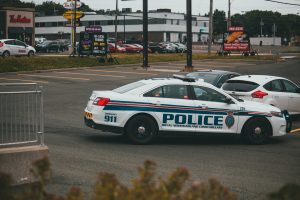
Watch “What’s in your bag? (Part 2)” here!
Reflection
My redesign is a fictional micro story told using voice-over accompanied by video and animation, or what the New London Group might refer to as a ‘discourse’ – ‘…a construction of some aspect of reality from a particular point of view, a particular angle, in terms of particular interests.” (1996, p. 78) The point of view is a fictionalized, or exaggerated, version of my own. The angle I am exploring is how certain types of power are wielded in society and how my relationship to that experience has changed. If there is a particular interest it is a brief reflection on social justice issues and how such interactions, as the one described in my story, play out differently for different groups in our society.
By telling a multi-modal story, by going beyond what the New London Group refer to as ‘mere literacy’, and including audio and visual elements and showing gestural meanings in, for example faces and hands, I am perhaps able to convey more meaning in a short space of time than I may have if this story was only in text form. However, the New London Group do not seem to give much consideration to the trade offs that are made when choosing to tell a story using multiple modes of expression compared to a more pared down form such as text. I am reminded how often lovers of a particular book are disappointed when the book is made into a film. By using the images I have chosen to tell my story with it might seem like I am even more forcefully imposing my view point on the person receiving my story and allowing them less opportunity to create in their minds their vision of the events. The casual viewer of my story would not know the images used to tell my story were not necessarily what I had in mind when I began to conceive of the story; they are simply what were available to me for free on Pixaby and Canva.
In the story I am trying to draw attention to the use of language, by reflecting on the different contexts in which a question like “What’s in your bag?” might be asked. The original ‘What’s in your bag?’ activity served as a friendly introduction to the ETEC 540 course. The New London Group describes ‘Available Designs’ in terms of genres articulating social relations and social positions. (1996, p.76). I took this as permission to do more than add additional grammars to the ‘What’s in your bag?” activity but to also try out the activity in different genres. ‘What’s in your Bag?’ could be a cheery daytime TV quiz show with contestants guessing the contents of each other’s bags based on their appearance and some small bits of biographical information. ‘What’s in your bag?’ could be a documentary telling the story of refugees who were forced to flee their homes and could grab only a few precious items to carry in their bag before leaving.
However, I settled on my story, which I think might be described as a melodrama, because for many people someone asking to see what’s in your bag would in most contexts be quite an invasive and unwelcome experience. The likely scenarios in which this would occur would be demonstrations of power and authority. The story gives me a chance to reflect on how my experience of being asked ‘What’s in your bag?’ by a person in authority could be different from someone from a different culture or social group. It is also an opportunity for me to reflect on how I have changed over the course of my life and how my relationship to authority has changed. In my teenage years and early twenties growing up where I did I had a strong disdain for police authority and a misguided sense of my own invincibility. I grew up in a part of the world, the north of Ireland, as part of a community that viewed the police force as a foe. Even though a lot has changed for me since then and I live in a very different context now I wonder what remnants of the older version of me remain.
Reference
Cazden, C., Cope, B., Kalantzis, M., Luke, A., Luke, C., Nakata, M., & New London Group. (1999;1996;). A pedagogy of multiliteracies designing social futures. In B. Cope, & M. Kalantzis (Eds.), (pp. 60-92). Routledge. https://doi.org/10.4324/9780203979402-6